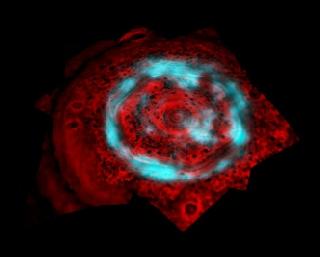
This file image of the northern polar region of Saturn shows both the aurora and underlying atmosphere, seen at two different wavelengths of infrared light as captured by NASA�s Cassini spacecraft. Photo: NASA/JPL/University of Arizona.
LONDON (PTI): Unravelling a long-standing puzzle in astronomy, an international team of scientists led by Dr Jonathan Nichols of the University of Leicester have discovered that Saturn's aurora, an ethereal ultraviolet glow which illuminates the planets upper atmosphere near the poles, pulses roughly once per Saturnian day.
The length of a Saturnian day has been under much discussion since it was discovered that the traditional 'clock' used to measure the rotation period of Saturn, a gas giant planet with no solid surface for reference, apparently does not keep good time.
Saturn, like all magnetised planets, emits radio waves into space from the polar regions.
These radio emissions pulse with a period near to 11 h, and the timing of the pulses was originally, during the Voyager era, thought to represent the rotation of the planet.
However, over the years the period of the pulsing of the radio emissions has varied, and since the rotation of a planet cannot be easily sped up or slowed down, the hunt for the source of the varying radio period has become one of the most perplexing puzzles in planetary science.
Now, in a paper to be published in Geophysical Research Letters (August 6), Nichols et al. use images from the NASA/ESA Hubble Space Telescope of Saturn's auroras obtained between 2005-2009 to show that, not only do the radio emissions pulse, but the auroras beat in tandem with the radio.
"This is an important discovery for two reasons. First, it provides a long-suspected but hitherto missing link between the radio and auroral emissions, and second, it adds a critical tool in diagnosing the cause of Saturn's irregular heartbeat.
"Auroras, more commonly known as the 'northern lights' on Earth, are caused when charged particles in space are funnelled along a planet's magnetic field into the planet's upper atmosphere near the poles, whereupon they impact the atmospheric particles and cause them to glow.
"This happens when a planet's magnetic field is stressed by, for example, the buffeting from the stream of particles emitted by the Sun, or when moons such as Enceladus or Io expel material into the near-planet space," Dr Jonathan Nichols said.
Saturn's radio waves were long suspected to be emitted by the charged particles as they hurtle toward the poles, but no radio-like pulsing had been observed in Saturn's aurora, an enigmatic disconnect between the two supposedly-related phenomena.
However, it was found that by using the clock of the radio pulsing to organise the auroral data, and stacking the results from all the Hubble Saturn auroral images obtained from 2005-2009 on top of each other, the auroral pulsing finally revealed itself.
"This confirms that the auroras and the radio emissions are indeed physically associated, as suspected. This link is important, since it implies that the pulsing of the radio emissions is being imparted by the processes driving Saturn's aurora, which in turn can be studied by the NASA/ESA spacecraft Cassini, presently in orbit around Saturn.
"It thus takes us a significant step toward solving the mystery of the variable radio period," Dr Nichols added.
 Previous Article
Previous Article Next Article
Next Article













The Indian Air Force, in its flight trials evaluation report submitted before the Defence Ministry l..
view articleAn insight into the Medium Multi-Role Combat Aircraft competition...
view articleSky enthusiasts can now spot the International Space Station (ISS) commanded by Indian-American astr..
view article